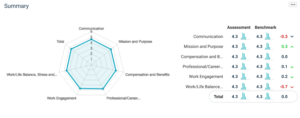Gain invaluable and trustworthy data with these tips
Welcome to the Knowledge Economy. In today’s complex business landscape knowledge is power. The guessing game is increasingly being taken out of all levels of organizations. It is being replaced by data driven insights and decision making. When it comes to gathering data needed to evaluate employee engagement and performance, companies are finding surveys to be one of the best tools in their arsenal.
They are also finding not any old survey will do. The most beneficial survey method available is 360-degree surveying. In 360-degree surveying anonymous feedback is collected from anyone who works with the reviewee on a regular basis: coworkers, subordinates, peers, supervisor. These quantitative and qualitative data points are combined with the employee’s self evaluation survey to accurately and fairly assess the reviewee’s overall behavior and performance, organizational effectiveness, employee engagement and job satisfaction.
While it isn’t difficult to administer a beneficial 360 degree survey campaign, successful administrators are finding that not all surveys are equal. There are tried and true best practices that should always be kept in mind throughout the process. We have compiled our top 18 tips to help you on your path to collecting accurate data and gaining invaluable insights.
Prepare for Success
Tip: Preparation is arguably the most important phase of a successful 360° survey implementation!
- Make sure the timing is right: Organizations with high degrees of trust among colleagues and management are good candidates for 360 feedback. If your company is undergoing a major restructure or if a blame culture currently exists, implementing a 360 process could have adverse effects. Make sure it is a good time to collect data!
- Define and communicate the process goals right off the bat: Hit the whiteboard at the start to make sure there is a clear idea of how the 360-degree feedback process fits within the overall employee development efforts. How often are you going to ask for feedback? What are you going to do with the results?
- Ensure buy-in throughout the organization: Communication from the get-go is key. You need to sell that this survey isn’t just a formality, aka a waste of time. Show that all levels of management are invested in the process. Make sure everybody knows why the 360 feedback process is being implemented and what the feedback will be used for. Establish that post-survey, resources will be invested to enact needed change. Employees will only provide honest feedback if they believe it will be used for the right reasons and if it is confidential. If you do ensure anonymity, it’s extremely important to properly communicate the value of the 360-degree feedback process works, how the feedback will be used and how the anonymity of respondents is guaranteed. Employees will not feel comfortable providing honest feedback if they do not trust the system.
Now Build It
- Find the right survey solution: First off, there is no need to recreate the wheel. Find the right employee performance management solution for your organization. Look for a product that provides 360 feedback surveys, performance appraisals, AND employee surveys. Keep in mind, there is no need to break the bank when integrating a simple, flexible, and affordable solution.
- Keep it Short and Simple: The Harvard Business Review recommends creating “ a survey that requires just 15 to 20 minutes to complete, to avoid the survey fatigue that tortuously long instruments cause.” Also, make sure your survey follows a logical order and that it takes a reasonable amount of time to complete. Otherwise users will checkout/be lost by the end.
- Make Sure Every Question Is Necessary: In the same vein as keeping it short, every question in the survey should be well thought out. Start by planning what insights you need and then work backward. Then pare down where possible. Also, when ensuring every question is necessary, really make sure you are asking the right questions that get to the core of possible organizational issues. Strive for clear and precise language that will make your questions easy to answer.
- Make Sure you Can Fix the Issue You are Asking About: Take a good look at every question and ask, “Do I know what actions the organization can take to fix this issue?” If the survey highlights an issue that can’t be fixed, you could be opening Pandora’s box.
- Ask One Question at a Time: If your questions contain the word “and”—it can be a red flag that your question has two parts. For example “Which of these services has the best customer support and reliability?” Customer support can be rated differently than reliability. Combining these two in one question could make the data on customer support and reliability misleading.
- Avoid Leading and Biased Questions: Make sure you aren’t pointing a reviewee towards a certain answer. In particular, evaluate the adjectives and adverbs in your questions. It is quite possible they are unnecessary.
Leading question: Should concerned pet owners RFID chip their dogs? By using the word concerned, you put pet owners not tracking their dogs on the defensive, thus creating bias. A more successful non-leading question would be: Do you think dogs should be chipped? - Speak The Respondent’s Language: Use language and terminology that your respondents will understand. As in the example below, keep it as simple as possible and try and avoid technical jargon.
Overcomplicated: What is the state of the cleanliness of the office?
Good question: How clean is the office? - Use Rating Scales Whenever Possible: Whether you’re performing employee satisfaction or employee engagement surveys, use good rating scales. Scales that display the direction and intensity of attitudes often provide useful data. On the other hand, binary response options such as true/false response options, generally produce less informative data. Most yes/no or true/false questions can be reworked by including phrases such as “How much,” “How often,” or “How likely.” When setting up the scale remember that an unbalanced response scale can mislead a respondent in the same way a poorly worded question might. Make sure your response scales have a definitive midpoint. Aim for odd numbers of possible responses. Also, ensure they cover the whole range of possible reactions.
- Provide “Not applicable” (N/A) response options: A N/A response is ok. A fake answer is not. Providing N/A response options prevents respondents from skipping questions or giving false answers.
Test it Out!
- Administer a pilot: You should run the process with a group of employees or only selected areas. Get real feedback on employees using the actual questionnaires you developed. This pilot project will allow you to validate your questionnaires and to address any concerns from participants. It will also allow you to get comfortable with the tools and get ready to prepare action plans based on the feedback and comments.
It is Go Time
- Choose appropriate respondents: For a 360-degree feedback survey make sure to involve a wide range people throughout the company that sufficiently know the employee under review. Primalogik 360 allows people being reviewed to suggest their own participants, providing valuable input at this stage of the process.
- Make sure people take it: Communicate effectively throughout the process and track progress with survey email. Utilize automated invitations and reminders to easily organize and administer your surveys.
Now the Real Work Starts
- Analyze the results: Now you have to dig into the data. Spend time analyzing the results. Don’t just send the raw results to employees without any analysis or pre-processing. When analyzing the results make sure you aren’t just looking at the averages, valuable insight often lays in the outliers. Use frequency distribution charts to gain better insight on how 360 feedback ratings are distributed across a group of respondents. Looking at the full range allows managers and HR personnel to identify areas of disagreement, performance gaps or opportunities for improvement.
- Use the data and follow-up with each employee: Effective leaders listen to the survey and enact necessary change. The easiest way to invalidate a survey campaign is to not convey management is listening and willing to make possibly difficult changes. After analyzing all the raw data make sure to produce an action plan for each one of your employees. Follow-up with each respondent at predetermined intervals to ensure they are making progress within their customized plan.
- Rinse and repeat: The 360-degree process is not a one time thing. Repeat the process and compare results to ensure the right behaviors are being reinforced, progress is being made, and that your people are developing the right competencies. The process can be polished, questionnaires can be perfected, questions can be refined. Just make sure you convey the value of each iteration and each respondent’s time. Or else the surveys will start wasting away in email purgatory.
When done correctly and coupled with a robust employee performance management plan 360-degree surveys can transform organizations. They can also drastically improve employee satisfaction. Let’s face it happy and engaged employees are at the core of successful businesses. Primalogik 360 is here to take the guess work out of employee engagement and directly ask employees about benefits, job satisfaction, work environment, and how satisfied they are with management. On top of that our 360-degree feedback reviews provide a wider and fairer view of your employees performance by incorporating anonymous feedback from coworkers, subordinates, peers and supervisors. Don’t just take our work for it, start a free trial today!







